#Commander Frank Borman
Explore tagged Tumblr posts
Text

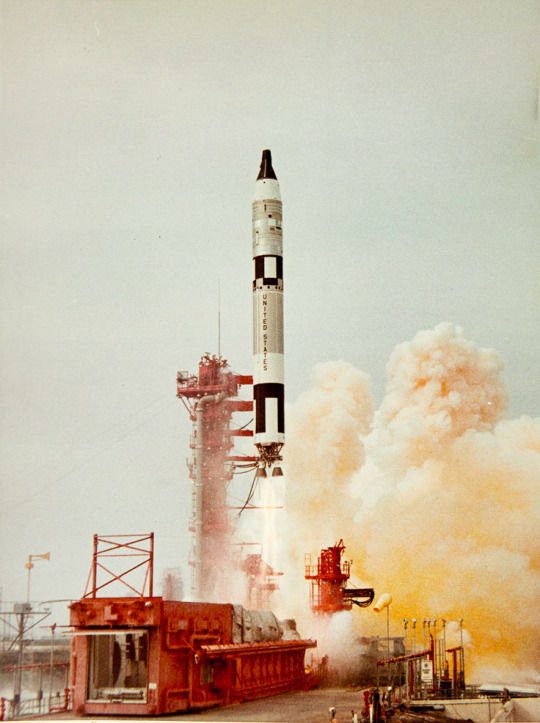
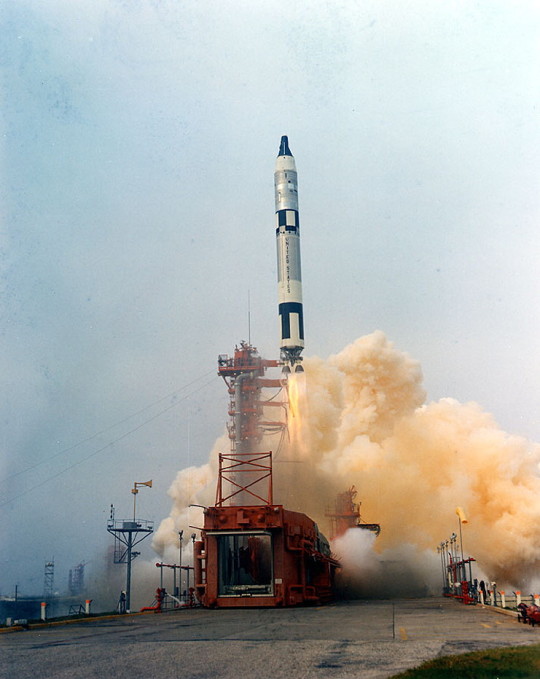
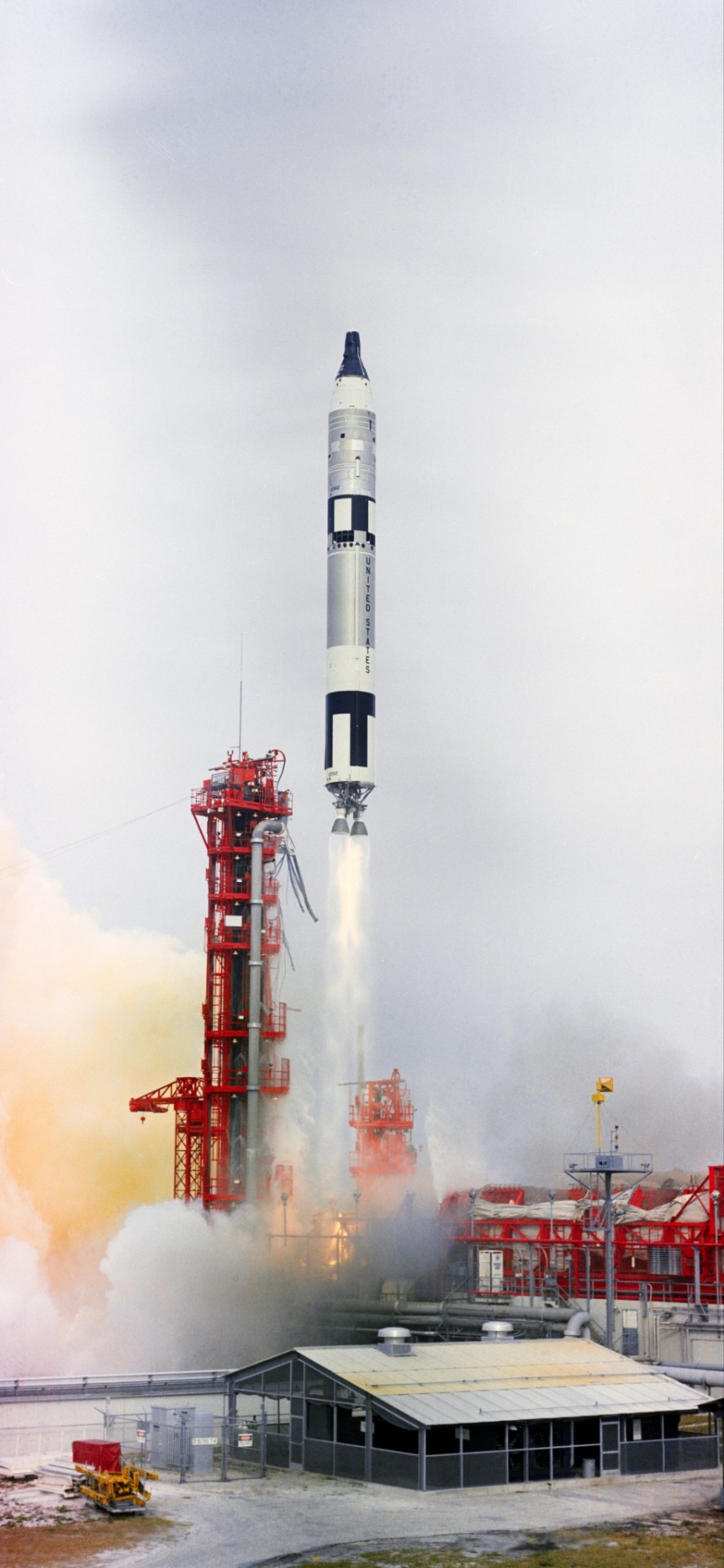
"The Gemini-7 spacecraft, carrying astronauts Frank Borman, command pilot, and James A. Lovell Jr., pilot, was successfully launched by the National Aeronautics and Space Administration from Pad 19 at 2:30 p.m., (EST) Dec. 4, 1965. The Gemini-7 spacecraft is scheduled for a 14-day mission in space."

Date: December 4, 1965
NASA ID: S65-61628, S65-61650, S65-61838, S65-54129
source, source, source
#GT-7#GT-VII#Gemini 7#Gemini VII#SC7#Gemini Titan#Titan II#Titan II GLV#GLV-7 12562#62-12562#Rocket#NASA#Gemini Program#Project Gemini#Gemini#LC-19#Cape Canaveral#Kennedy Space Center#KSC#Florida#Wally Schirra#Thomas Stafford#Launch#December#1965#my post
93 notes
·
View notes
Text
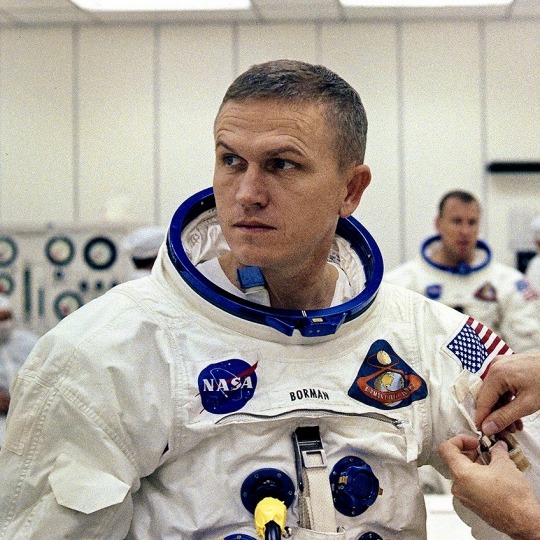
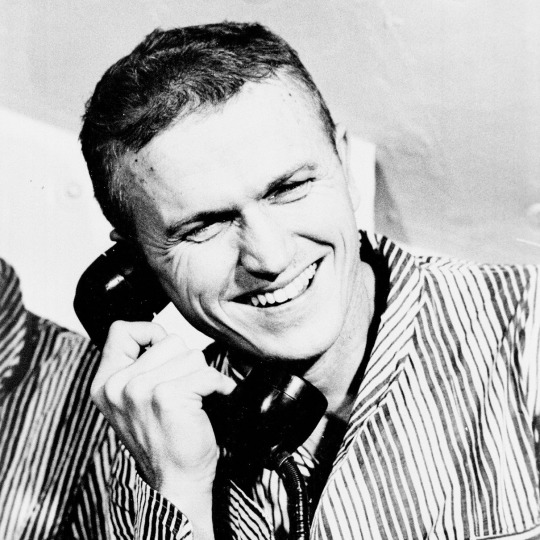



Remembering Col. Frank Frederick Borman II (March 14, 1928 – November 7, 2023), who passed away earlier this week at the incredible age of 95.
What an incredible life he had. Frank was the commander of Gemini VII and Apollo 8 and one of the first humans to fly around the moon. Until his death, he was the oldest living American astronaut—now his best friend Jim Lovell, who is 11 days younger, holds the distinction.
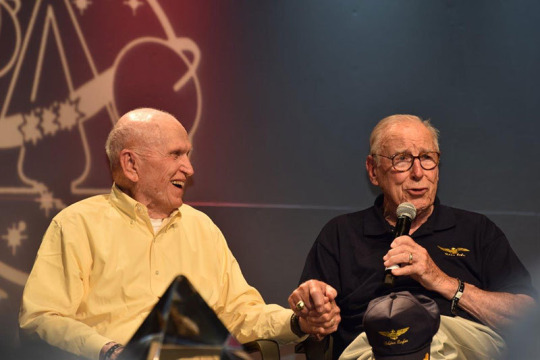
Frank’s beloved wife Susan, to whom he was married for over 70 years, passed away in 2021 and they are survived by their two sons.


Frank will be remembered as one of NASA’s best and brightest. He was known to be direct and to-the-point with a sharp sense of humor to match.
Every December 24th, I listen to Apollo 8’s Christmas Eve broadcast from lunar orbit in 1968, which included the crew’s recitation from Genesis and Frank’s message to the world: “Good night, good luck, a Merry Christmas —and God bless all of you, all of you on the good Earth.” I’ll do so again this year with a little sadness and a lot of gratitude to Frank and his extraordinary life.
"When you're finally up at the moon looking back on earth, all those differences and nationalistic traits are pretty well going to blend, and you're going to get a concept that maybe this really is one world and why the hell can't we learn to live together like decent people." Frank Borman (1928-2023)
389 notes
·
View notes
Text

Earth Rise - December 25th, 1995.
"During the 1968 Christmas season, Frank Borman, James Lovell, and William Anders flew the Apollo 8 command module from the Earth, to the Moon and back (launched December 21st, achieved 10 lunar orbits, landed December 27th). The Apollo 8 mission's impressive list of firsts includes; the first manned flight using the Saturn V rocket, the first humans to journey to the Earth's Moon, and the first to photograph Earth from deep space. The famous picture above, showing Earth rising above the Moon's limb as seen from lunar orbit, was a marvelous gift to the world. This was astronaut James Lovell's third mission. His last flight would be as commander of Apollo 13."
86 notes
·
View notes
Text

On Christmas Eve 1968, as commander of Apollo 8 – the first manned lunar orbital mission – Frank Borman, who has died aged 95, came out with words that, alongside Neil Armstrong’s “giant leap for mankind”, from Apollo 11 in 1969, and Jack Swigert and Jim Lovell’s “OK, Houston, we’ve had a problem”, from Apollo 13 in 1970, defined an era.
In that moment before the moon programme became mundane, when astronauts were prime time, Apollo 8’s broadcast ended with the crew – Bill Anders, Lovell and Borman – reading the story of Earth’s creation as written in the book of Genesis.
It was Borman’s conclusion, “Good night, good luck, a merry Christmas and God bless all of you, all of you on the good Earth”, that clinched it. For Gene Kranz, Nasa’s chief of flight control operations in Houston, the phrase was “literally magic. It made you prickly. You could feel the hair on your arms rising, and the emotion was just unbelievable.”
Thus, for some, the traumatic 1968 of the ongoing Vietnam war, the assassinations of Martin Luther King and Robert Kennedy, and the crushing of Czechoslovakia, had been transcended. From a distance – around 238,855 miles – it was still, apparently, the good Earth.
Around two years earlier, Nasa had been in crisis. On 27 January 1967, Gus Grissom, Ed White and Roger Chaffee had been incinerated on Apollo 1 during a test launch. Borman was appointed to the Nasa board which, that April, reported on the fire, slamming Nasa management and North American Aviation for its “ignorance, sloth and carelessness”.
Borman was then sent to North American’s plant in Downey, California – where drunkenness had been rife – to scrutinise command module redesign. “Borman set them straight,” wrote the second man on the moon, Buzz Aldrin, in Men from Earth (1989). “His shoot-from-the-hip management style – some called it bullying – worked.”
The Mercury programme had put astronauts in space. Gemini – to which Borman had been recruited in 1962 – had honed the business of Apollo: to fulfil President John F Kennedy’s goal of a manned moon landing by the end of the decade. In December 1965, Borman and Lovell had made their space debut with a record 14 days of orbit on Gemini 7, and also made a rendezvous with Gemini 6.
In the wake of the 1967 tragedy there were three unmanned Apollo launches, with mixed results. But in September 1968 the unmanned Soviet Zond 5’s orbit of the moon triggered alarm in the US. The Soviets had launched Sputnik, and the space age, in 1957. The first man in space, Yuri Gagarin, had orbited Earth in April 1961. That, along with the furore around the Bay of Pigs fiasco, had helped propel JFK into making his rash pledge in May 1961.
Seven years on, in autumn 1968, Nasa and the CIA were asking whether history was going to repeat itself. Would a Russian be first around the moon? That October, the Apollo 7 astronauts, Wally Schirra, Walter Cunningham and Donn Eisele, spent a successful, albeit cold-ridden and fractious, 10 days in orbit around the Earth. There were rows with ground control. None of those three would get another mission.
Nasa needed a breakthrough. Rather than the next planned Earth orbit, Apollo 8 was to be sent to the moon and, after the astronaut Jim McDivitt turned down the offer, Borman got the job. On 21 December, following a morale-boosting visit from the aviator Charles Lindbergh, Borman, Lovell and Anders blasted off.
Borman’s greatest fear, wrote Andrew Chaikin in A Man on the Moon (1994), was that the moon mission would be aborted and Apollo 8 would be confined to orbiting the Earth. It did not happen, but en route Borman was afflicted by vomiting and diarrhoea, the detrital consequences of which floated on, to be trapped by paper towels. The three men orbited the moon 10 times in 20 hours, descended to 69 miles above the rock’s surface, and were the first to witness the far side of what Borman called “a great expanse of nothing”.
It was on the fourth orbit that Borman spotted the Earth rising from behind the moon – an image that Anders captured on colour film and became known as Earthrise. “Oh my God! Look at the picture over there. Here’s the Earth coming up,” Borman is recorded shouting in a transcript.
Born in Gary, Indiana, Frank was the son of Edwin Borman, who ran an Oldsmobile dealership, and Marjorie (nee Pearce). The family moved to Tucson, Arizona, where his mother opened a boarding house, and Frank went to the local high school. He first flew as a teenager, in 1943. Seven years later he graduated from West Point Military Academy in New York state.
From 1950 Borman flew F-84 fighter-bombers with the US Air Force. A perforated ear drum denied him Korean war combat experience. In 1957 he gained a master’s in aeronautical engineering from the California Institute of Technology and became an assistant professor of thermodynamics and fluid mechanics at West Point.
Three years later he graduated from the Aerospace Research Pilot School at Edwards air force base in California. There, his aircraft included the controversial Mach 2 Lockheed F-104 Starfighter. It was in 1962 that, alongside Armstrong, Lovell and others, he became one of Nasa’s Gemini programme “New Nine”. Apollo 8 proved what had been evident to insiders for many years: that the US had won the space race. Borman, Anders and Lovell became Time magazine’s 1968 men of the year.
Having achieved the rank of colonel in the mid-1960s, Borman retired from the USAF and space flight and, after a sojourn at Harvard Business School, joined Eastern Air Lines. By 1975 he was Eastern’s CEO and a year later became chairman. But by the late 70s competition was intensifying, labour relations were deteriorating and Borman – never a diplomat – was in the firing line. He quit the company in 1986 when it was taken over by a corporate raider, and Eastern collapsed five years later.
He and his wife, Susan (nee Bugbee), whom he had married in 1950, moved to New Mexico, where he remained involved in business interests. They later settled in Billings, Montana, where he had a cattle ranch and rebuilt vintage aircraft. A supporter of Richard Nixon and both George Bushes, Borman was a man of brisk views. Among the many targets of his ire were the sound barrier-breaking pilot Chuck Yeager, the Democratic party presidential candidate Michael Dukakis and the scientist Carl Sagan.
He received many honours, including the Congressional Space Medal of Honor in 1978, and published his autobiography, Countdown, in 1988.
Susan died in 2021. His sons, Frederick and Edwin, four grandchildren and six great-grandchildren survive him.
🔔 Frank Frederick Borman II, astronaut, born 14 March 1928; died 7 November 2023
Daily inspiration. Discover more photos at Just for Books…?
12 notes
·
View notes
Text

[During his time in the Texas Air National Guard] there were a stream a reminders that George W. Bush wasn't just another rank-and-file military pilot.
The most memorable came in early 1969 when his father [George H.W. Bush], who was throwing a party at Washington's Alibi Club for Apollo 8's commander, Frank Borman, called his son with a proposition. "How would you like to fly up to Washington for a dinner with an astronaut?" he asked in a phone call, adding that he had also invited first daughter Tricia Nixon. "I thought it might be fun if you took her to the party," he said. Taken aback and noncommittal at first, George W. accepted the blind date only after betting his doubtful flight school buddies that the invitation was real. He found himself fifty dollars richer when a military plane later arrived at Moody [Air Force Base] to whisk him off to Washington for the occasion.
In spite of his father's best matchmaking intentions, the date ended up a bust. What started less than auspiciously, with George W. entering through the gates of the White House for the first time in his life -- behind the wheel of a purple AMC Gremlin, complete with Levi's denim seats, that he had borrowed from his parents -- ended up with the President's elder daughter asking to return home just after dinner. "Being a swashbuckling pilot, I had taken to drink," George W. recalled of the date much later. "I reached for some butter, knocked over a glass and watched in horror as a stain of red wine crept across the table. Then I fired up a cigarette prompting a polite suggestion from Tricia that I not smoke." When he returned to the dinner after escorting Ms. Nixon home, a friend of his father discreetly asked, "Get any?" Not even close, Bush replied.
-- George W. Bush's disastrous blind date with President Richard Nixon's eldest daughter, Tricia Nixon, in 1969, as recounted by Mark K. Updegrove in The Last Republicans: Inside the Extraordinary Relationship Between George H.W. Bush and George W. Bush (BOOK | KINDLE | AUDIO)
#History#Presidents#George W. Bush#Bush 43#President Bush#George H.W. Bush#Richard Nixon#President Nixon#Tricia Nixon#First Families#First Daughters#First Sons#First Children#Children of the Presidents#Presidential Families#Presidential Children#Before They Were President#Political History#Politics#The Last Republicans#Mark K. Updegrove#The Last Republicans: Inside the Extraordinary Relationship Between George H.W. Bush and George W. Bush#Presidential Relationships#Bush Family#Nixon Family#Tricia Nixon Cox
6 notes
·
View notes
Text
R.I.P. William Anders.
William Anders, a NASA astronaut who was part of the 1968 Apollo 8 crew who were the first three people to orbit the moon, has died in a plane crash in Washington state, according to his son, Gregory Anders. He was 90 years old. My “dad passed in an aircraft incident in the San Juan Islands,” Anders told CNN Friday evening. “The family is devastated and grieving the loss of a great pilot,” he added. The San Juan County Sheriff’s Office said in a news release an aircraft went down off the coast of Jones Island. [ ... ] William Anders, born on October 17, 1933, in Hong Kong, graduated from the United States Naval Academy in 1955 and after being commissioned in the US Air Force, he earned his pilot’s wings the following year, according to the US Naval Academy’s website. [ ... ] Anders and fellow astronauts Jim Lovell and mission commander Frank Borman, who died in November 2023, flew aboard the first lunar orbit mission in December 1968 on Apollo 8. Anders served as the lunar module pilot for the historic flight. From the spacecraft, Anders captured an iconic image of Earth showing the moon’s surface in the foreground during the Apollo 8 flight on Christmas Eve 1968, titled “Earthrise.” “We came all this way to explore the moon, and the most important thing is that we discovered the Earth,” Anders famously said.
Although the first moon landing by Apollo 11 in 1969 was a great technological achievement, I think the Apollo 8 mission in 1968 may have had a greater impact on the way humans think about our neck of the cosmos.
The first flight beyond low Earth orbit put our planet in perspective and made people understand how precious and vulnerable it is.
The Earthrise photo became instantly iconic. It gave momentum to the environmental movement and the first Earth Day was marked in 1970.

BTW, the Apollo 8 command module is now on display at Chicago's Museum of Science and Industry in the Hyde Park neighborhood which also includes University of Chicago.
#william anders#apollo 8#nasa#astronauts#space travel#usa#earthrise#lunar orbit#the environmental movement#chicago#museum of science and industry
2 notes
·
View notes
Text
on this day in 1969
Frank Boman at the Palace



American astronaut Colonel Frank Borman, Commander of the Apollo 8 mission, visits the Queen, Prince Philip, Princess Anne and Prince Edward at Buckingham Palace, with his wife Susan, 4th February 1969. He is on a nineteen-day goodwill tour of Europe.
#on this day#queen elizabeth ii#prince philip#duke of edinburgh#princess anne#princess royal#prince edward#earl of wessex
21 notes
·
View notes
Text

55 years ago... Goodwill tour Between February 4 & 23, 1969, Apollo 8 commander Frank Borman took his family on a European Goodwill tour, visiting London, Paris, Brussels, The Hague, Bonn, West Berlin, Rome, Madrid and Lisbon. A military academy West Point graduate, Borman choose to be commissioned as a USAF fighter pilot, following the test pilot course by 1960. Selected a NASA astronaut in 1962, Borman flew on Gemini VII and Apollo 8, the first circumnavigation of the Moon. Note the NASA-issued Omega Speedmaster 105.012 on a steel mesh Jacoby Bender Champion bracelet, had its bezel missing. (Photo: NASA)
#Apollo#Astronaut#321#chronograph#Omega#Speedmaster#Moonwatch#MoonwatchUniverse#NASA#test pilot#military#montres#uhren#horloges#spaceflight#JBchampion#Zulu time
3 notes
·
View notes
Text

Happy 95th Birthday Frank Borman! Command Pilot for Gemini VII, first rendezvous of spacecraft. Commander for Apollo 8, first manned ship to leave Earth orbit for deeper space.
17 notes
·
View notes
Text
Enjoy this post I discovered about NASA astronauts taking drugs.
Apollo astronauts took Seconal during at least three missions. Mission Commander Frank Borman took Seconal during the Apollo 8 mission. At least two Apollo astronauts took Seconal while on the surface of the moon. Sleeping on the moon was apparently very difficult during Apollo 11 and Apollo 12
I mean you always wondered, right?
Plus they took a lot of speed.
6 notes
·
View notes
Text
Jim Lovell
James Arthur Lovell Jr. (/ˈlʌvəl/; born March 25, 1928) is an American retired astronaut, naval aviator, test pilot and mechanical engineer. In 1968, as command module pilot of Apollo 8, he became, with Frank Borman and William Anders, one of the first three astronauts to fly to and orbit the Moon. He then commanded the Apollo 13 lunar mission in 1970 which, after a critical failure en route, circled the Moon and returned safely to Earth.
A graduate of the United States Naval Academy in Annapolis, Maryland, in the class of 1952, Lovell flew F2H Banshee night fighters. This included a Western Pacific deployment aboard the aircraft carrier USS Shangri-La. In January 1958, he entered a six-month test pilot training course at the Naval Air Test Center at Naval Air Station Patuxent River, Maryland, with Class 20 and graduated at the top of the class. He was then assigned to Electronics Test, working with radar, and in 1960 he became the McDonnell Douglas F-4 Phantom II program manager. The following year he became a flight instructor and safety engineering officer at Naval Air Station Oceana in Virginia Beach, Virginia, and completed Aviation Safety School at the University of Southern California.
Lovell was not selected by NASA as one of the Mercury Seven astronauts due to a temporarily high bilirubin count. He was accepted in September 1962 as one of the second group of astronauts needed for the Gemini and Apollo programs. Prior to Apollo, Lovell flew in space on two Gemini missions, Gemini 7 (with Borman) in 1965 and Gemini 12 in 1966. He was the first person to fly into space four times. One of 24 people to have flown to the Moon, Lovell was the first to fly to it twice. He is a recipient of the Congressional Space Medal of Honor and the Presidential Medal of Freedom. He co-authored the 1994 book Lost Moon, on which the 1995 film Apollo 13 was based. Lovell was featured in a cameo appearance in the film.
2 notes
·
View notes
Text


"The crew of the Gemini-7 spaceflight, astronauts Frank Borman, command pilot, and James A. Lovell Jr., pilot, arrived aboard the aircraft carrier USS WASP. The astronauts were picked up from the ocean, following a successful splashdown, by recovery helicopter and flown to the carrier to begin postflight medical and technical debriefings."
Date: December 18, 1965
NASA ID: S65-61830, S65-63646
#GT-7#GT-VII#Gemini 7#Gemini VII#NASA#Gemini Program#Project Gemini#Gemini#Recovery#Atlantic Ocean#USS WASP (CV-18)#USS WASP#Essex Class#Aircraft Carrier#Ship#December#1965#my post
32 notes
·
View notes
Text
#FromLunarOrbit "And from the crew of Apollo 8,
We close with good night,
Good luck, a #merryChristmas,
And God bless all of you—
All of you on the good Earth."
--Frank Borman, commander of the #Apollo8 mission https://www.nasa.gov/missions/apollo/apollo-8-christmas-at-the-moon/
1 note
·
View note
Text
Events 12.4 (1910-1980)
1917 – The Finnish Senate submits to the Parliament of Finland a proposal for the form of government of the Republic of Finland and issued a communication to Parliament declaring the independence of Finland. 1918 – U.S. President Woodrow Wilson sails for the World War I peace talks in Versailles, becoming the first US president to travel to Europe while in office. 1919 – Ukrainian War of Independence: The Polonsky conspiracy is initiated, with an attempt to assassinate the high command of the Revolutionary Insurgent Army of Ukraine. 1928 – Cosmo Gordon Lang was enthroned as the Archbishop of Canterbury, the first bachelor to be appointed in 150 years. 1939 – World War II: HMS Nelson is struck by a mine (laid by U-31) off the Scottish coast and is laid up for repairs until August 1940. 1942 – World War II: Carlson's patrol during the Guadalcanal Campaign ends. 1943 – World War II: In Yugoslavia, resistance leader Marshal Josip Broz Tito proclaims a provisional democratic Yugoslav government in-exile. 1943 – World War II: U.S. President Franklin D. Roosevelt closes down the Works Progress Administration, because of the high levels of wartime employment in the United States. 1945 – By a vote of 65–7, the United States Senate approves United States participation in the United Nations. (The UN had been established on October 24, 1945.) 1948 – Chinese Civil War: The SS Kiangya, carrying Nationalist refugees from Shanghai, explodes in the Huangpu River. 1949 – Sir Duncan George Stewart, governor of the Crown Colony of Sarawak, was fatally stabbed by a member of the Rukun 13. 1950 – Korean War: Jesse L. Brown (the 1st African-American Naval aviator) is killed in action during the Battle of Chosin Reservoir. 1950 – Korean War: Associated Press photographer Max Desfor photographs hundreds of Korean refugees crossing a downed bridge in the Taedong River: 1951 Pulitzer Prize winner Flight of Refugees Across Wrecked Bridge in Korea. 1956 – The Million Dollar Quartet (Elvis Presley, Jerry Lee Lewis, Carl Perkins, and Johnny Cash) get together at Sun Studio for the first and last time. 1964 – Free Speech Movement: Police arrest over 800 students at the University of California, Berkeley, following their takeover and sit-in at the administration building in protest of the UC Regents' decision to forbid protests on UC property. 1965 – Launch of Gemini 7 with crew members Frank Borman and Jim Lovell. The Gemini 7 spacecraft was the passive target for the first crewed space rendezvous performed by the crew of Gemini 6A. 1969 – Black Panther Party members Fred Hampton and Mark Clark are shot and killed during a raid by 14 Chicago police officers. 1971 – The PNS Ghazi, a Pakistan Navy submarine, sinks during the course of the Indo-Pakistani Naval War of 1971. 1971 – During a concert by Frank Zappa and The Mothers of Invention at the Montreux Casino, an audience member fires a flare gun into the ceiling, causing a fire that destroys the venue. The incident served as the inspiration for Deep Purple's 1973 song Smoke on the Water. 1974 – Martinair Flight 138 crashes into the Saptha Kanya mountain range in Maskeliya, Sri Lanka, killing 191. 1977 – Jean-Bédel Bokassa, president of the Central African Republic, crowns himself Emperor Bokassa I of the Central African Empire. 1977 – Malaysian Airline System Flight 653 is hijacked and crashes in Tanjong Kupang, Johor, killing 100. 1978 – Following the murder of Mayor George Moscone, Dianne Feinstein becomes San Francisco's first female mayor.
0 notes
Link
Following the success of the Apollo 8 circumlunar mission, NASA believed that it could achieve a Moon landing by the summer of 1969 and meet President John F. Kennedy’s goal. Much work remained to accomplish that objective. Three crews and their backups trained for the next three Apollo missions while workers at NASA’s Kennedy Space Center (KSC) in Florida prepared the spacecraft and rockets for those flights. With Apollo 9 in the home stretch to test the Lunar Module (LM) in Earth orbit in early March, preparations also continued for Apollo 10 in May, a lunar orbit test of the LM that served as a dress rehearsal for the Moon landing, and for Apollo 11, the landing mission itself planned for July. Apollo 8 Left: Apollo 8 astronaut Frank Borman and his wife Susan, at left, meet the Royal family at Buckingham Palace during the London stop of their European tour. Middle: Borman, left, meets with French President Charles de Gaulle and U.S. Ambassador to France R. Sargent Shriver during the Paris stop of the tour. Right: In Brussels, Borman, left, presents a model of the Saturn V rocket to Jean Rey, president of the European Commission. Left: In Den Haag, The Netherlands, Apollo 8 astronaut Borman, right, describes the Lunar Module to Queen Juliana. Middle: At The Vatican, Borman, left, presents a photograph of the Moon from Apollo 8 to Pope Paul VI. Right: The Bormans, Frank, left, Susan, and sons Edwin and Frederick, hold a press conference in Lisbon, the last stop of their European tour. As President Richard M. Nixon announced on Jan. 30, Apollo 8 astronaut Frank Borman, his wife Susan, and their two children Frederick and Edwin, set off on their European goodwill tour on Feb. 2, flying aboard a presidential Air Force jet. Borman’s Apollo 8 crewmates James A. Lovell and William A. Anders could not participate in the tour because they had already begun training as part of the Apollo 11 backup crew. The Bormans’ 19-day tour took them to London, Paris, Brussels, Den Haag, Bonn, West Berlin, Rome, Madrid, and Lisbon. They met with royalty, politicians, scientists, and Pope Paul VI, gave lectures during which Borman narrated a film from his flight, and held numerous press conferences. Apollo 9 Left: Apollo 9 astronauts Russell L. Schweickart, left, James A. McDivitt, and David R. Scott pose in front of the control panel for the spacecraft simulators. Middle: Fisheye lens view of Schweickart, left, and McDivitt in the Lunar Module simulator. Right: A technician poses in the Apollo A7L spacesuit, including the Portable Life Support System backpack used for the first time during Apollo 9. Apollo 9 astronauts James A. McDivitt, David R. Scott, and Russell L. Schweickart planned to conduct the first crewed test of the LM during their 10-day Earth orbital mission. They and their backups Charles “Pete” Conrad, Richard F. Gordon, and Alan L. Bean spent many hours in the spacecraft simulators and training for the spacewalk component of the mission. The planned spacewalk, the first and only one before the Moon landing mission, would not only test the spacesuit and its Portable Life Support System but also demonstrate an external crew transfer should a problem arise with the internal transfer tunnel or hatches. McDivitt, Scott, and Schweickart provided details of their mission to reporters during a press conference on Feb. 8 at the Manned Spacecraft Center (MSC), now NASA’s Johnson Space Center in Houston. They explained that during the mission phase when the two vehicles fly separately, they will use the call signs Spider for the LM and Gumdrop for the Command Module (CM), lighthearted references to the shapes of the respective spacecraft. Left: Apollo 9 astronauts Russell L. Schweickart, left, James A. McDivitt, and David R. Scott during the preflight crew press conference at the Manned Spacecraft Center (MSC), now NASA’s Johnson Space Center in Houston. Right: Senior NASA management assembled for the Apollo 9 Flight Readiness Review at NASA’s Kennedy Space Center (KSC): Associate Administrator for Manned Flight George E. Mueller, left, Apollo Program Director Samuel C. Phillips, KSC Director Kurt H. Debus, MSC Director Robert R. Gilruth, and Marshall Space Flight Center Director Wernher von Braun. Senior NASA managers met at NASA’s Kennedy Space Center (KSC) in Florida for Apollo 9’s Flight Readiness Review the first week of February. At the end of the meeting, they set the launch date for Feb. 28. The following week, engineers in Firing Room 2 of KSC’s Launch Control Center conducted the Countdown Demonstration Test (CDDT), essentially a dress rehearsal for the actual countdown. On Feb. 12, McDivitt, Scott, and Schweickart participated in the final portion of the CDDT, as they would on launch day, by donning their spacesuits and climbing aboard their spacecraft for the final two hours of the test. Engineers began the countdown to launch on Feb. 26 but had to halt it the next day when the astronauts developed head colds. Managers reset the launch date to March 3, and the countdown restarted on March 1. Left: The Apollo 9 Saturn V at Launch Pad 39A at NASA’s Kennedy Space Center in Florida during the Countdown Demonstration Test (CDDT). Middle: Engineers in the Launch Control Center’s Firing Room 2 monitor the rocket and spacecraft during the CDDT. Right: Apollo 9 astronauts Russell L. Schweickart, left, David R. Scott, and James A. McDivitt pose in front of their Saturn V following the CDDT. Apollo 10 Stacking of the Apollo 10 vehicle in High Bay 2 of the Vehicle Assembly Building at NASA’s Kennedy Space Center in Florida. Left: The three stages of the Saturn V stacked on Mobile Launcher-3. Middle left: The Apollo 10 spacecraft, the Command and Service Modules and the Lunar Module (LM) encased in the Spacecraft LM Adapter, arrives from the Manned Spacecraft Operations Building. Middle right: Workers lift the spacecraft for stacking onto the rocket, the footpads of the LM’s folded landing gear visible. Right: Workers lower the spacecraft onto the Saturn V rocket’s third stage. With Apollo 9 on Launch Pad 39A and almost ready to launch, workers in High Bay 2 of KSC’s Vehicle Assembly Building (VAB) completed stacking of the Apollo 10 launch vehicle. The spacecraft, consisting of the Command and Service Modules atop the LM encased in the Spacecraft LM Adapter, arrived from the Manned Spacecraft Operations Building (MSOB) on Feb. 6 and VAB workers stacked it on the Saturn V rocket the same day. Engineers began to conduct integrated tests on the launch vehicle in preparation for rollout to Launch Pad 39B in mid-March. Apollo 10 astronauts Thomas P. Stafford, John W. Young, and Eugene A. Cernan and their backups L. Gordon Cooper, Donn F. Eisele, and Edgar D. Mitchell spent much time in spacecraft simulators and testing their spacesuits in vacuum chambers. Apollo 11 Left: Apollo 11 astronaut Edwin E. “Buzz” Aldrin, left, confers with support astronauts Ronald E. Evans and Harrison H. “Jack” Schmitt, the only geologist in the astronaut corps at the time, during training for deployment of the Early Apollo Science Experiment Package (EASEP). Right: Astronaut Don L. Lind, suited, practices deploying the EASEP instruments as Aldrin, in white shirt behind the dish antenna, oberves. With their historic mission only five months away, the Apollo 11 prime crew of Neil A. Armstrong, Michael Collins, and Edwin E. “Buzz” Aldrin and their backups James A. Lovell, William A. Anders, and Fred W. Haise busied themselves training for the Moon landing. Although the primary goal of the first Moon landing mission centered on demonstrating that the Apollo spacecraft systems could safely land two astronauts on the surface and return them safely to Earth, the surface operations also included collecting lunar samples and deploying experiments. During their two-and-a-half-hour surface excursion, Armstrong and Aldrin planned to deploy three instruments comprising the Early Apollo Surface Experiment Package (EASEP) – a passive seismometer, a laser ranging retro-reflector, and a solar wind composition experiment. On Jan. 21, 1969, astronauts Harrison H. “Jack” Schmitt, the only geologist in the astronaut corps, and Don L. Lind conducted a simulation of the EASEP deployment in MSC’s Building 9. Aldrin observed the simulation, obviously with great interest. Left: Apollo 11 astronauts Edwin E. “Buzz” Aldrin, left, and Neil A. Armstrong during geology training at Sierra Blanco, Texas. Right: Apollo 11 backup astronauts Fred W. Haise, left, and James A. Lovell at the Sierra Blanco geology training session. Generic instruction in geology, including classroom work and field trips, became part of overall NASA astronaut training beginning in 1964. Once assigned to a crew that had a very good chance of actually walking on the lunar surface and collecting rock and soil samples, those astronauts received specialized instruction in geology. On Feb. 24, 1969, the two prime moonwalkers Armstrong and Aldrin, along with their backups Lovell and Haise, participated in their only trip specifically dedicated to geology training. The field exercise in west Texas took place near Sierra Blanca and the ruins of Fort Quitman, about 90 miles southeast of El Paso. Accompanied by a team from MSC’s Geology Branch, the astronauts practiced sampling the variety of rocks present at the site to obtain a representative collection, skills needed to choose the best sample candidates during their brief excursion on the lunar surface. Left: Workers mount the S-IC first stage on its Mobile Launcher in the Vehicle Assembly Building at NASA’s Kennedy Space Center in Florida. Middle: Neil A. Armstrong stands in front of the Lunar Module simulator at the Lunar Landing Research Facility (LLRF) at NASA’s Langley Research Center in Hampton, Virginia. Right: Aerial view of the LLRF at Langley. By mid-February, all three stages of the Apollo 11 Saturn V had arrived in the VAB, and on Feb. 21, workers stacked the S-IC first stage on its Mobile Launcher in High Bay 1. They finished assembling the rocket in March. In an altitude chamber in the nearby MSOB, on Feb. 10, engineers conducted a docking test between the CM and the LM. Five days later, they mated the ascent and descent stages of the LM for further testing. With the Lunar Landing Training Vehicle (LLTV) still grounded following its December 1968 crash, the Lunar Landing Research Facility (LLRF) at NASA’s Langley Research Center in Hampton, Virginia, remained as the only high-fidelity trainer for the descent and landing of the LM on the Moon. Armstrong practiced landings in the LLRF on Feb 12. Lunar Receiving Laboratory and Mobile Quarantine Facility To minimize the risk of back contamination of the Earth with any possible lunar microorganisms, NASA designed and built the 83,000-square-foot Lunar Receiving Laboratory (LRL), residing in MSC’s Building 37. The facility isolated the astronauts, their spacecraft, and lunar samples to prevent any Moon germs from escaping into the environment, and also maintained the lunar samples in as pristine a condition as possible. The Mobile Quarantine Facility (MQF) provided isolation for the returning astronauts from shortly after splashdown until their delivery to the LRL, an activity that required transport of the MQF on a cargo jet aircraft. On Feb. 6, following its return from sea trials, workers placed the MQF inside Chamber A of MSC’s Space Environment Simulation Facility. The test in the large vacuum chamber checked out the MQF’s emergency oxygen supply during a simulated aircraft pressure loss. Three test subjects successfully completed the test. Left: Workers truck the Mobile Quarantine Facility (MQF) into the Space Environment Simulation Laboratory (SESL) at the Manned Spacecraft Center, now NASA’s Johnson Space Center in Houston. Middle: Workers install the MQF in Chamber A of the SESL for a test of the emergency oxygen system. Right: Test subjects inside the MQF prepare for the emergency oxygen system test in the SESL. To be continued … News from around the world in February 1969: Feb. 3 – Ibuprofen launched in the United Kingdom as a prescription anti-inflammatory analgesic. Feb. 5 – The population of the United States reaches 200 million. Feb. 7 – British band The Who record their song “Pinball Wizard.” Feb. 7 – Diane Krump becomes the first woman jockey at a major U.S. racetrack (Hialeah, Florida). Feb. 8 – The Allende meteorite weighing nearly two tons explodes in mid-air and fragments fall on Pueblito de Allende, Chihuahua, Mexico. Feb. 9 – First flight of the Boeing 747 Jumbo Jet from Everett, Washington. Feb. 21 – First launch of U.S.S.R.’s N-1 Moon rocket, not successful. Feb. 24 – U.S. launches Mariner 6 to fly-by Mars. Share Details Last Updated Feb 20, 2024 Related TermsNASA HistoryApollo Explore More 7 min read 30 Years Ago: Clementine Changes Our View of the Moon Article 4 days ago 3 min read NASA Goddard’s Beginnings in Project Vanguard Article 4 days ago 8 min read 55 Years Ago: President Nixon Establishes Space Task Group to Chart Post-Apollo Plans Article 1 week ago
0 notes
Text
55 Years Ago: Seven Months Before the Moon Landing
December 1968 ended a year more turbulent than most. For the American space program, however, it brought the Moon landing one giant step closer. The successful first lunar orbital flight by Apollo 8 astronauts Frank Borman, James A. Lovell, and William A. Anders proved the space worthiness of the Apollo Command and Service Modules (CSM) […] from NASA https://ift.tt/zI1Td26
0 notes